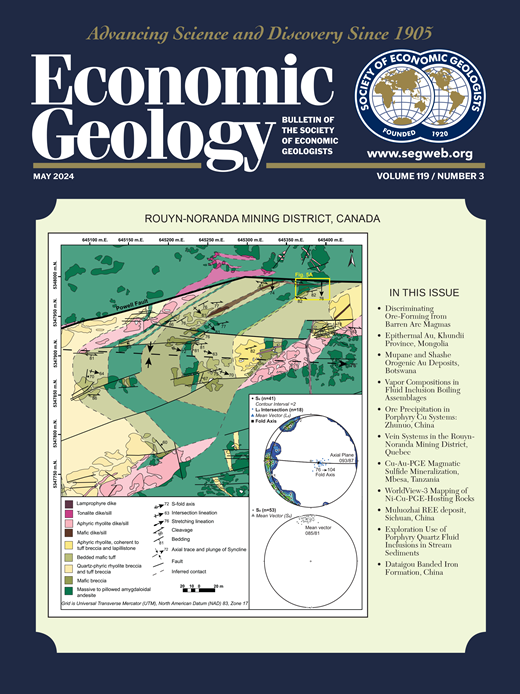索尔顿海地热田Li的特征
IF 4.9
1区 地球科学
Q1 GEOCHEMISTRY & GEOPHYSICS
引用次数: 0
摘要
在索尔顿海地热田,锂在地热卤水和宿主岩相互作用中的行为是不受约束的。锂盐储层的储量在400万至1800万吨碳酸锂当量之间,而储层岩石矿物相中的储量则更大。本文通过对Salton海地热田2-14科学钻探岩心和商业井中矿物的体岩和卤水Li浓度、δ7Li和原位Li浓度的研究,确定了锂的矿物寄主,并约束了盐岩相互作用过程中锂的行为。绿泥石中锂含量最高(270 ~ 580 ppm, ~ 2358 m),绿泥石包裹着黄铁矿,表明锂是在热液蚀变过程中从卤水中固定到寄主岩石中的。绿泥石中锂丰度随深度(70 ~ 100 ppm, ~2,882 m)降低,全岩锂含量降低,而全岩δ7Li增加(~2,485 m, δ7Li = 2.0 ~ 4.3‰;~2,819 ~ ~2,882 m, δ7Li = 4.3 ~ 7.9‰)。在~2,500 m处,Li的行为变化表明Li在绿泥石中的分配取决于温度;在深度&;gt;~ 2500 m,对应于储层~325℃。卤水δ7Li = 3.7 ~ 4.7‰,计算的卤水与寄主岩石之间的同位素分馏因子与~325℃时Li行为的变化一致。简单的封闭系统批量建模不能描述地热系统,提示索尔顿海地热田内Li的开放系统行为。本文章由计算机程序翻译,如有差异,请以英文原文为准。
Characterization of Li in the Salton Sea Geothermal Field
The behavior of lithium during geothermal brine and host-rock interactions in the Salton Sea geothermal field is underconstrained. The lithium brine reservoir inventory is between 4 and 18 million metric tons of lithium carbonate equivalent, with an even larger amount present within the reservoir rock mineral phases. Here, we present bulk-rock and brine Li concentration and δ7Li, and in situ Li concentrations of minerals from the California State 2-14 scientific drill core and commercial wells in the Salton Sea geothermal field to identify the mineral hosts of Li and constrain Li behavior during brine-rock interactions. Lithium contents are highest in chlorite (270–580 ppm, ~2,358 m), which encases pyrite, indicating that Li is fixed from the brine into the host rocks during hydrothermal alteration. Lithium abundances in chlorite decrease with depth (70–100 ppm, ~2,882 m), as does whole-rock Li content, whereas whole-rock δ7Li increases (δ7Li = 2.0–4.3‰, ~2,485-m depth; δ7Li = 4.3–7.9‰ from ~2,819 to ~2,882 m). This change in behavior of Li at ~2,500 m suggests temperature dependent partitioning of Li in chlorite; Li becomes more incompatible in chlorite at depths >~2,500 m, corresponding to ~325°C in the reservoir. The brines have δ7Li = 3.7 to 4.7‰ and calculated isotopic fractionation factors between the brine and the host rock agree with a change in Li behavior at ~325°C. Simple closed-system batch modeling does not describe the geothermal system, suggesting open-system behavior of Li within the Salton Sea geothermal field.
求助全文
通过发布文献求助,成功后即可免费获取论文全文。
去求助
来源期刊

Economic Geology
地学-地球化学与地球物理
CiteScore
10.00
自引率
6.90%
发文量
120
审稿时长
6 months
期刊介绍:
The journal, now published semi-quarterly, was first published in 1905 by the Economic Geology Publishing Company (PUBCO), a not-for-profit company established for the purpose of publishing a periodical devoted to economic geology. On the founding of SEG in 1920, a cooperative arrangement between PUBCO and SEG made the journal the official organ of the Society, and PUBCO agreed to carry the Society''s name on the front cover under the heading "Bulletin of the Society of Economic Geologists". PUBCO and SEG continued to operate as cooperating but separate entities until 2001, when the Board of Directors of PUBCO and the Council of SEG, by unanimous consent, approved a formal agreement of merger. The former activities of the PUBCO Board of Directors are now carried out by a Publications Board, a new self-governing unit within SEG.
 求助内容:
求助内容: 应助结果提醒方式:
应助结果提醒方式:


